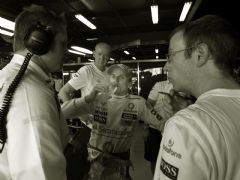Lately, I have been spending my spare time studying some courses on strategic planning & strategic analysis, in order to supplement my experiential learning & skills learnt from my mentors, with some more formal learning.
I am really enjoying working through business examples & applying the same lessons to sports performance settings. It is also interesting to see why large multi-national organisations fail & see if the same mistakes would have a similar impact in a sporting context.
The examples of Kodak, Rios or Remington Typewriters all demonstrate an inability to innovate effectively, adapt their methods to a shifting trends, evolve their structures & be flexible enough to initiate the changes required to respond to disruptions in their market.
Now, change the industries & names before considering the shifting trends encountered by sporting organisations when rule changes occur. For example, think about the implications on teams of the technical rule changes in Formula 1, or the introduction of Bosman rulings or abolition of reserve leagues in favour of U-21 leagues in European soccer, or the introduction of the Collective Bargaining Agreements in both the NBA & NFL.
As you’d expect, it seems that the boards of dominant companies can become complacent with the success in their industry; underestimate the threat of new technology or new players in the marketplace; fail to properly undertake a timely succession-planning process & some just become so comfortable in doing what they do, they become too scared to take the risks required to change course.
Could these be issues that Liverpool FC failed to consider after Dalglish left in the early nineties? What about factors that have precipitated the fall from grace that the LA Lakers have experienced? On the flip side, are these aspects of sports management that organisations such as the San Antonio Spurs or the New Zealand All Blacks have excelled at, enabling them to achieve prolonged status as leading organisations amongst their competitors?
Sometimes the boards of the companies that fall from grace, have been lazy with recruitment & the decision makers have surrounded themselves, intentionally or otherwise, with people from the same type of background or with “echo chambers”. As such it becomes easy to stagnate & exposure to new ways of thinking or problem solving becomes restricted.
This situation reminds me of a fascinating TED talk I watched recently by Margaret Heffernan, entitled “Dare to Disagree”. Margaret talks about the danger of surrounding yourself with people that are most likely to agree with you & the benefits of selecting people that challenge your methods to work the most closely with you.
Click here to watch Margaret’s thought-provoking presentation:
Heffernan, M. Dare to Disagree. TED.com
Whilst it can be uncomfortable to challenge the default setting of bringing people into a team that you know, trust & are “on your wavelength”, maybe people you have worked closely with before aren’t those most likely to challenge you in new & more difficult ways. Which candidates are more likely to help the team move forward & break new ground? Could it be that a mix of both “tried & trusted” & “new school upstarts” is the ideal recipe?
When I was building the performance science & medical services team at Hearts FC several years ago, my aim was to assemble a group of people from a wide variety of backgrounds & a spread of different specialist skill sets. Some with experience in football, many with none.
My thinking was that there would be less resistance to sharing ideas, more desire to learn off each other & in turn we would create a team less likely to suffer from the insecurities that stunt the growth of many teams in sport.
My rationale was that if everyone I brought in was smarter than me & came from different experiential backgrounds, the group would look at things differently to how the other football teams would look at things & as such be better suited to innovating in order to gain performance advantages over the competition.
By definition, the new team members would challenge my every move or thought process & by asking the pertinent questions, then giving each person the freedom to operate & supporting them in their actions, we would achieve far more than if I lead the team armed with my knowledge alone. Yes, I had to provide the vision & the overall philosophy but I didn’t need to provide the answer to every problem, the solution to every challenge.
I think for my first attempt it worked well but since then I have evolved my methods for searching out the best talent & tweaked my selection processes. I have learned a lot from my valued mentors who have built teams both in sport but also in other industries, as well as through reading & doing courses.
Coincidentally, as I was writing the plan for this article I saw a couple of quotes, one by Sir Richard Branson & one by the late Steve Jobs, which resonated & earned a place in the blog.
Firstly, when it comes to the type of people that you want to engage with, Richard Branson suggests that…
“The most talented, thought-provoking, game-changing people are never ‘normal’.”
Secondly, once you have recruited the best people, Steve Jobs was famous for saying…
“It doesn’t make sense to hire smart people & then tell them what to do; we hire smart people so they can tell us what to do.”
When it comes to creating success & building teams that “do”, who am I to argue with two masters of the game?!

